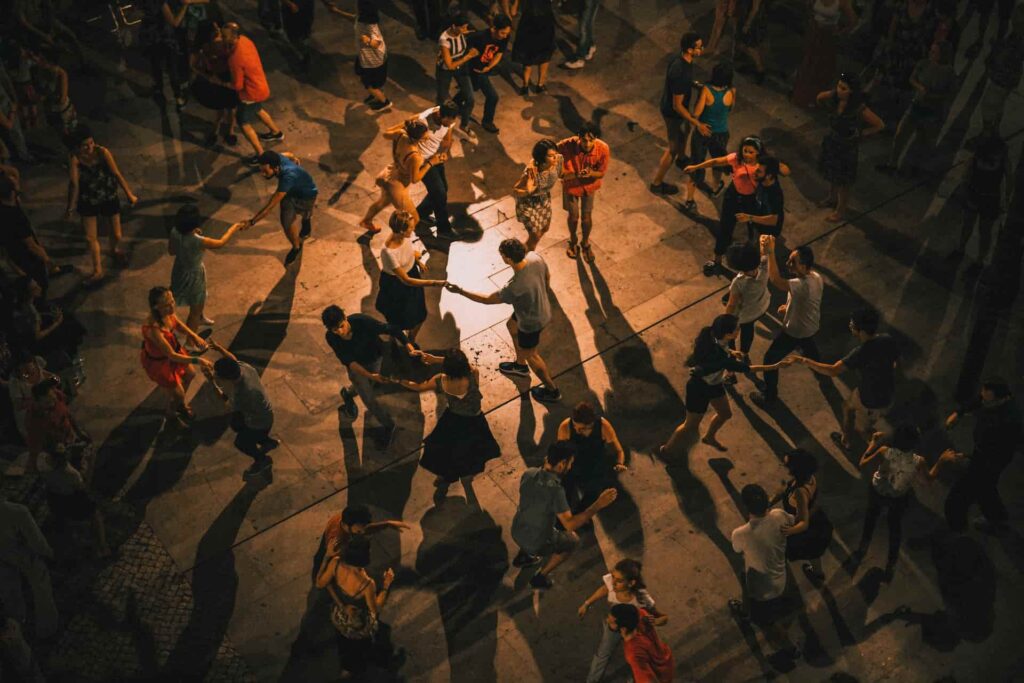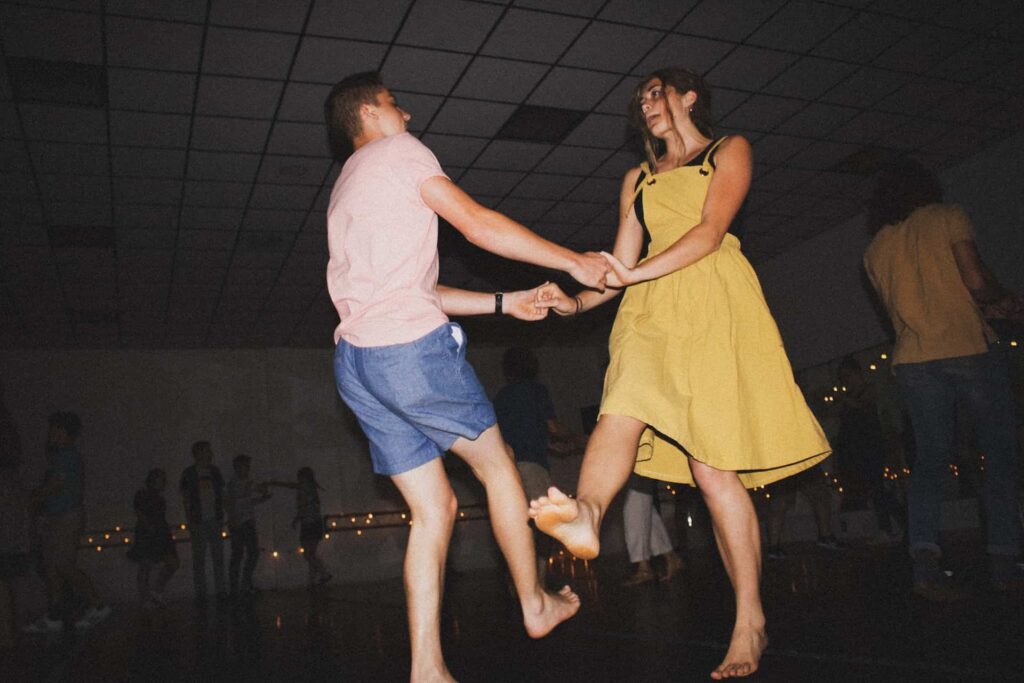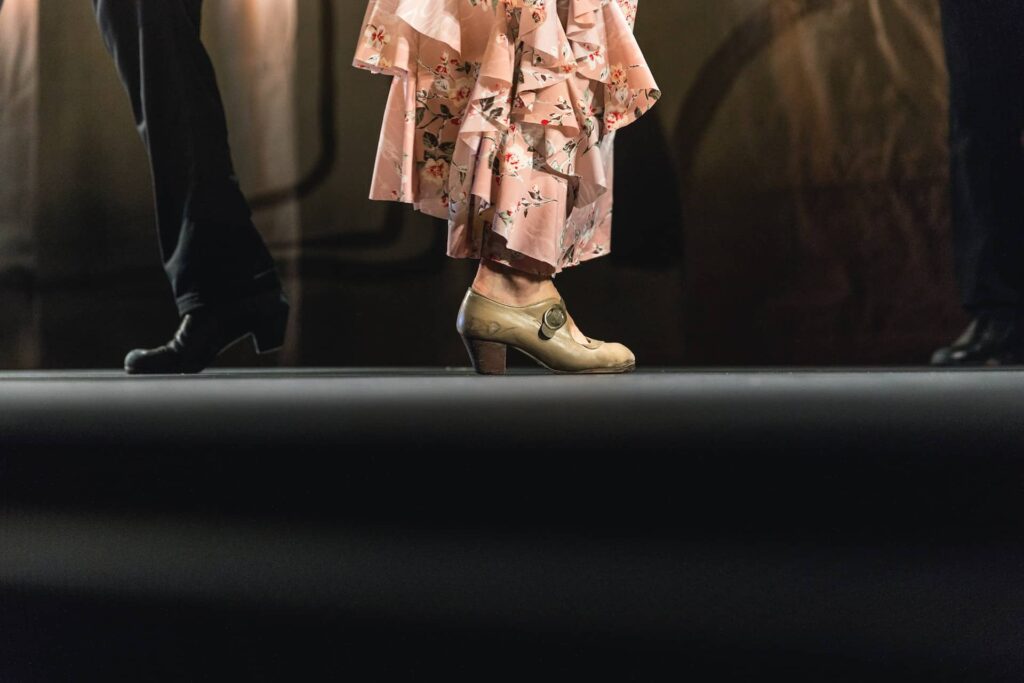
Summary
Welcome » Welcome » Guide to dance types » Acrobatic rock dance: the dance that combines spectacle and energy
Acrobatic rock dance: the dance that combines spectacle and energy
There acrobatic rock dance is a form of artistic expression that combines acrobatics, dance And strength. This is an exciting universe that contains unique characteristics. It is a dance that has conquered the world to such an extent that it has left a significant impact on the contemporary artistic scene.
Summary
History of acrobatic rock dance
Acrobatic rock dancing originated in the United States in the 1950s. It is a type of dance based on six-step rock where acrobatics are performed. This discipline brought together different styles and ended up being one of the most influential dances when it comes to competition. But if this dance got there, it is thanks to its history and its evolution, which we will see in a moment.
Origin
Acrobatic rock had its beginnings in 1850 with the Cake-walk, a couple dance created by the slave community of the time to parody their masters. Then, it was adopted by white people. To the point that in 1924, the hi-hat appeared. Then, boogie-woogie in 1940. After the Second World War, jitterbug, the ancestor of acrobatic rock, appeared in France.
The beginnings of acrobatic rock dance are found in the rock'n'roll. This discipline revolutionized the musical and cultural world in the 1950s in the United States. During this period, young people wanted to explore new forms of entertainment and dance. This is why the frantic rhythm of rock'n'roll seduces them, giving birth to a liberating dance, far from traditional dances.
Thus, little by little, the dancers began to integrate acrobatic elements to give a spectacular dimension to performance. From the 1970s and 1980s, acrobatic rock dance experienced a new boom with the arrival of competitions. With this new concept, dancers from all backgrounds have the opportunity to demonstrate their talent, their mastery, dancing with confidence. Also, acrobatic rock dancing is a pair dance, so couples can distinguish themselves byexecution of rapid complex movements and by their sync level.
The evolution
Over the decades, acrobatic rock has surrounded itself with diverse influences. Particularly with classic rock'n'roll elements, as well as other styles like boogie-woodie, THE swing, lindy hop, be bop and sometimes no contemporary dance.
Today, acrobatic rock dance continues to interest dancers and spectators around the world. The proof being that high-level competitions have been set up to push the limits and creativity of the discipline. Also, schools and studios offer courses accessible to all levels.

Basic acrobatics in acrobatic rock
Acrobatic rock dancing is an activity that combines the energy of rock'n'roll with acrobatics to create an impressive performance. There are many acrobatics categories with some different and specific goals, which we will discover right away.
Aerial lifts
Aerial lifts are acrobatics where a dancer lifts their partner into the air in order to bring a effect of grace and of suspension. This type of movement requires precise coordination, a total trust in the other and one exceptional mastery of technique. But the most important thing is trust. Indeed, the dancers who are held in the air must feel in security and be confident about their partner's ability to execute the movement correctly. In the same way, the dancer must have a perfect mastery of technology and intuitively understand the needs and limits of your partner.
Techniques and production
For a successful air lift, you must have rigorous training and perfect mastery of the technique.
To begin, dancers must develop a big Muscular force, focusing on the muscles of the trunk, legs and arms. Also, they have to work endurance to maintain demanding postures during dancing. Then another key element is the communication. Indeed, partners must communicate openly to ensure that they are on the same page in terms of technique and if adjustments are necessary during the movement. Furthermore, it is imperative to progress gradually to achieve more complex movements. Finally, dancers must be prepared for possible emergencies and prioritize safety above all else.
Controlled falls
Controlled falls are used to give a dramatic aspect to performance. These are movements where a dancer leans back or is thrown backwards by their partner, only to be caught by the latter with grace. Compared to what the name suggests, this figure is minutely choreographed with precision which testifies to the high level of skill of the dancers who practice the controlled fall.
The fall is a meticulous acrobatics composed of strength, of coordination and D'balance. In addition, the dancer who is launched must be able to maintain a controlled posture in the air. While his partner must be fast, accurate And able to safely support the weight of their partner.
Points worked during training
During a rehearsal, dancers must develop a strong core muscle base, also valid for the legs in order to maintain precise positions during falls. Then, the dancers must understand perfectly For anticipate the movements of the other for precise and secure execution.
The doors
The lifts in acrobatic dance are elevations. They allow you to create moments of suspension with some positions complex And aesthetic. But, they ask for a exceptional synchronization and blind trust in one's partner.
Furthermore, there are several types of scopes:
- The horizontal carry : In this style of lift, the dancer is held horizontally in the arms of his partner.
- The vertical lift : Here the dancer is lifted vertically to create an expressive scene.
- The extended reach : This is carried at arm's length by your partner to create an impression of floating.
- The roll-up lift : The dancer is wrapped around the partner in a sculptural posture.
- Two-handed carry : Both partners participate in the lift, which creates harmony.
Spectacular jumps
Spectacular jumps are one of the essential components of acrobatic rock dancing. Indeed, these aerial movements captivate the public by creating moments of suspense. In addition, these acrobatics stand out for their dynamism and their ability to give the impression of defy gravity. But, there is not just one category of jumps, there are several :
- The simple jump : We are talking here about a vertical jump where the dancers leave the ground to return to a standing position.
- High jump : This is a vertical jump which aims to reach the greatest height possible.
- The split jump : It is a horizontal jump where the dancer's legs are spread in the air.
- The rotational jump : These are jumps where the dancers perform a complete or partial rotation in the air.
- The tuck jump : This is a jump where the legs are folded towards the torso during the elevation.
Body preparation
To successfully complete one of these jumps, dancers must have a strong leg muscles to propel his partner into the air. Then they must to coordinate And synchronize their movements in order to avoid collisions and guarantee good reception. Also, they must ensure the security reception by being prepared for certain emergency situations.
Position figures
Positional figures in acrobatic rock dance are distinctive elements of the practice. In fact, the dancers form aesthetic and artistic poses. Moreover, this is the aim of these figures, they must give a elegant and creative dimension to the discipline, in the same style as certain postures in figure skating. Obviously, this type of acrobatics comes in several forms. shapes.
The figures
- The curled figure : This is a moment when the dancers embrace and position themselves to form a spiral or loop.
- The balanced figure : This is when a dancer balances on a specific part of their partner's body to form a stable image.
- The stretched figure : The dancers form an elongated, flowing line by stretching the body in opposite directions.
- The hanging figure : The dancer is supported in a frozen position to accentuate the effect of suspension.
- The interlock figure : The dancers intertwine to form a complex structure.
For these figures to be successful, the dancers must have a increased sense of balance and an sharp coordination. Even though each movement is choreographed, dancers must wear a special attention to limb position, body weight distribution and contact points.
An acrobatic rock choreography
To master a choreography, it is essential to know the basic movements that form the foundations of acrobatic rock dancing. We will explore them and then develop a basic choreography as well as that of rock'n'roll.
Basic movements
In acrobatic rock, you have 4 movements that recur regularly:
- The kicks: These are lifted leg movements bringing a touch of boldness and liveliness.
- The swivels: These are hip rotations.
- The spins: These are rotational movements starting from the foot.
- A twist: This is an upper body rotation.
The basic structure
An acrobatic rock choreography begins with a artistic vision. That is to say, building a story or transmitting an emotion through movements, poses and acrobatics. Each element must be studied to be sure that it follows a fluid narrative. Then comes the music selection. This is an important choice since it defines the rhythm, the emotion and the energy that must be put into the performance. After what, the integration of dynamic movements such as aerial lifts, jumps or falls is done. Then, to bring aesthetics to the choreography, position figures are added. In addition, the dancers work on their coordination and their synchronization as well as their trust And understanding the other.
Rock'n'roll choreography
To get started, choose your music, it is a fundamental choice which determines the atmosphere. Opt for rhythmic and energetic songs. Then, establish a structure. This involves defining distinct sections, each corresponding to a specific moment in the music. Start defining the highlights of the music to highlight them through eye-catching moves or challenging acrobatics. After which you can create acrobatic passages playing with aerial lifts or drops. Then focus on the basic movements like kicks, twists or spins. They have to fit naturally into the choreography. Continue by adding position figures like windings or sculptural figures. Finally, work on your synchronization, balance and energy with your partner.

What you must remember
Before being acrobatic rock as we know it, this dance also had its beginnings. It was in 1850 that the first traces of acrobatic rock appeared, these were parodies of masters who held slaves. Then between the 1920s and 1940s, dances similar to acrobatic rock emerged. In particular, the boogie-woogie where the hi-hat. In reality, it was in the 1950s that acrobatic rock took shape by adding acrobatic elements to the dances.
Acrobatic figures
To understand what we are talking about, we have seen the different acrobatics present in acrobatic rock dance:
- Aerial lifts for an effect of grace and suspension.
- Controlled falls to give a dramatic effect.
- The doors which are elevations made to give complexity and aesthetics. You can exercise the carried horizontally; the vertical carry; the carried in extension; the rolling lift And carried with two hands.
- Spectacular jumps to appear to defy gravity. Jumps come in several categories: the simple jump; high jump ; split jump; rotational jump And the tuck jump.
- Position figures to give an elegant and creative dimension. Moreover, you will find several forms there: the curled figure; the balanced figure; the stretched figure; the hanging figure And the interlock figure.
Learn to choreograph
To successfully complete an acrobatic dance choreography, it is important to know the no basis which are the following:
- The kicks
- The swivels
- Spins
- A twist
Also we saw the steps that must be followed to perform a choreography:
- Create an artistic vision of the choreography
- Select music
- Integrate dynamic movements
- Add position figures
- Work on coordination, synchronization, trust and understanding with your partner
Finally, we were interested in the rock'n'roll choreography which goes like this:
- Choice of music
- Establish the structure of the choreography
- Perform acrobatic passages
- Add basic movements
- Setting up positional figures
- Work on synchronization, energy and balance with your partner
Work on your movements at DECIBEL ®
What if it was time for you to learn to dance? It’s possible at DECIBEL ®!
For dance lovers, DECIBEL ® invites you to dance while drawing your abs, thighs and glutes during 45-minute intensive workout sessions. As a bonus, you strengthen your cardio and muscles !
Have fun on creative choreographies which will make your movements come naturally thanks to the playlists composed of Beyoncé through Daft Punk and Drake. Don't be afraid of the gaze of others, free yourself under dim light and trust our coaches there to make you have a good time!
See you soon at DECIBEL ®!
Read also
follow us
on instagram
Follow our news,
take advantage of our tutorials and participate to our
contests!
BREAKING NEWS!
Receive our newsletter.






